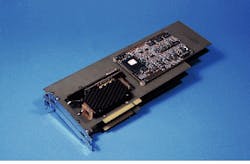OPTICAL PROCESSING: Miniature optical correlator fits inside a PC
Innovative packaging may finally bring optical processing into the mainstream of computing. The prototype "Flash 256" Fourier optical processor is about the size of two audio-cassette boxes stacked on top of each other and can perform 1000 image correlations per second (see figure). OCA Applied Optics (a division of Optical Corporation of America; Garden Grove, CA), plans to make the processor commercially available some time this spring. The optics module will come mounted on a pair of PCI (peripheral component interconnect) compatible cards for use in Pentium-, 486- and some Macintosh-based personal computers. The processor is a basic Vander Lugt correlator, although OCA says it can easily be reconfigured to operate in joint-transform mode. If the volume for a particular design is high enough—in the hundreds or thousands—the hardware cost could be as low as $5000–$15,000, depending on the configuration. Full menu-driven software will also be available.
The processor's basic function is to determine if two images, an incoming and a reference, either match or have some features in common. Images, or scenes, from the real world are obtained with a CCD camera, the output of which is fed into a 256 × 256 ferroelectric liquid crystal display (LCD). Light from a 10-mW 670-nm laser diode picks up the image from the display; this image is then optically Fourier transformed. In the transform plane the light encounters another LCD; this one acts as a filter by displaying a stored image that has been transformed electronically. The filter and the transform of the input scene interfere, and the resulting pattern is then inverse-transformed and analyzed. Where correlation peaks appear, the images match.
This product is the latest of a series of correlators that OCA Applied Optics has developed. Its work in this field started in 1985 with a contract from the US Army Missile Command (MICOM, Redstone Arsenal, AL). Since then, it has received $14 million in research contracts. A recent product, a shoebox-size version of the Flash 256, was used to demonstrate an optical correlator that could analyze synthetic aperture radar (SAR) data. This system will take very-large-format SAR images and segment them for processing. Each of the segments will be fed into one of seven separate optical correlators and the results combined and analyzed together. According to OCA, the system will compare SAR images to 300 different filters in less than 8 seconds. MICOM also sponsored this project, and the Army plans to test the new system early this year.
The Flash 256 project is funded by ARPA through a Phase II SBIR grant, with the aim of satisfying both military and commercial requirements. Applications such as factory automation, security, guidance, and navigation are among the possibilities for the optical correlator. Once the SAR correlator system has been tested, it will be reconstructed using the smaller, lighter component correlators. If these devices take off as computer peripherals for basic machine vision and other optical correlation tasks, they may also succeed in proving that hybrid optoelectronic computing has a future.
Sunny Bains | Contributing Editor
Sunny Bains is a contributing editor for Laser Focus World and a technical journalist based in London, England.
